Click on images to enlarge
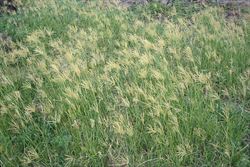
infestation (Photo: Sheldon Navie)
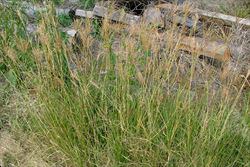
upright habit (Photo: Sheldon Navie)
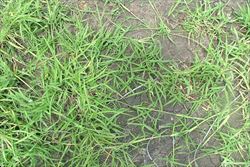
creeping habit (Photo: Sheldon Navie)
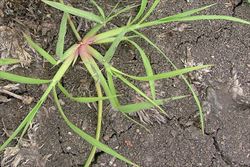
creeping stem rooting at its joints (Photo: Sheldon Navie)
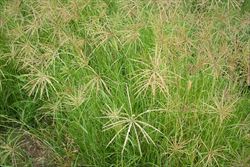
flowering stems and seed-heads (Photo: Sheldon Navie)
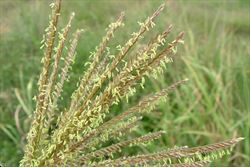
seed-head in flower (Photo: Sheldon Navie)
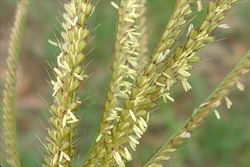
close-up of flower spikelets (Photo: Sheldon Navie)
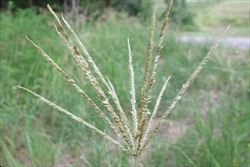
mature seed-head (Photo: Sheldon Navie)
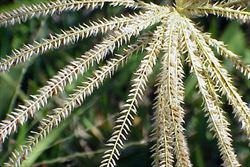
close-up of mature seed-head branches (Photo: Sheldon Navie)
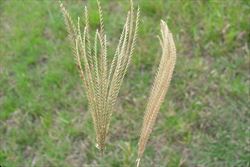
old seed-heads (Photo: Sheldon Navie)
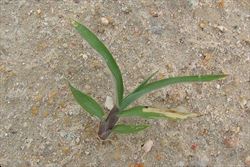
seedling (Photo: Sheldon Navie)
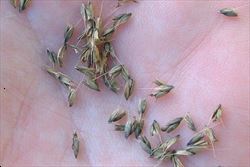
'seeds' (Photo: Sheldon Navie)
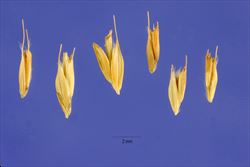
close-up of 'seeds' (Photo: Steve Hurst at USDA PLANTS Database)
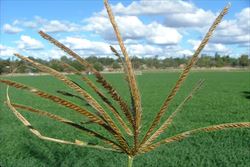
Callide Rhodes grass (Chloris gayana 'Callide'), with longer awns on its 'seeds' (Photo: Sheldon Navie)
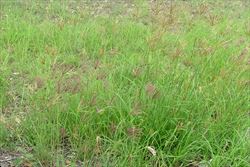
comparison of the growth habit of purpletop Rhodes grass (Chloris inflata), on the left, and Rhodes grass (Chloris gayana), on the right (Photo: Sheldon Navie)
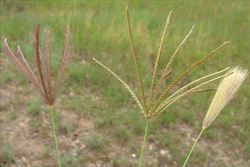
comparison of the young seed-heads of purpletop Rhodes grass (Chloris inflata), on the left, Rhodes grass (Chloris gayana), in the centre, and feathertop Rhodes grass (Chloris virgata), on the right (Photo: Sheldon Navie)
Scientific Name
Chloris gayana Kunth
Synonyms
Chloris abyssinica Hochst. ex A. Rich.
Family
Gramineae (South Australia)Poaceae (Queensland, New South Wales, the ACT, Victoria, Tasmania, Western Australia and the Northern Territory)
Common Names
hunyanigrass, Rhodes chloris, Rhodes grass, Rhodesgrass, Rhodesian blue grass
Origin
Native to sub-Saharan Africa (e.g. Ethiopia, Somalia, Sudan, Kenya, Tanzania, Uganda, Mali, Niger, Senegal, Mozambique and Zimbabwe), but its exact native range in obscure.
Cultivation
This species is widely cultivated as a pasture grass, particularly the cultivar known as Callide Rhodes grass (i.e. Chloris gayana 'Callide').
Naturalised Distribution
This species is naturalised in all mainland states and territories, and also on Lord Howe Island and Norfolk Island. It is most common and widespread in eastern Australia (i.e. in Queensland, New South Wales, ACT and Victoria). Also scattered throughout many parts of the Northern Territory and South Australia, and recorded from the northern and south-western parts of Western Australia.
Naturalised beyond its native range in Africa and in other parts of the world (i.e. the USA, New Zealand, Hawaii and several other Pacific islands).
Habitat
A weed of roadsides, railways, disturbed sites, parks, gardens, footpaths, orchards, vineyards, cultivation (e.g. plantation crops, cotton, sown pastures and summer crops), grasslands, open woodlands, floodplains and waterways (i.e. riparian areas) in tropical, sub-tropical, semi-arid and warmer temperate regions.
Habit
A long-lived (i.e. perennial) grass usually growing 0.4-1.6 m tall, but occasionally reaching up to 2 m in height. It forms small clumps with upright stems (i.e. erect culms) and also produces creeping (i.e. stoloniferous) stems.
Distinguishing Features
- a large grass with upright flowering stems (up to 1.5 m tall) as well as creeping stems.
- its very elongated leaves (8-28 cm long and 2-10 mm wide) are mostly hairless.
- its greenish-brown seed-heads are borne at the tops of the stems.
- each seed-head has several branches (5-10 cm long) that radiate from the same point.
-
the branches have numerous flower spikelets, which leave two small bracts behind when they fall off.
Stems and Leaves
The upright (i.e. erect) flowering stems (i.e. culms) are hairless (i.e. glabrous) and usually branched. These stems (2-4 mm thick) are often slightly bent at the base (i.e. geniculate) and are tough and wiry in nature. The creeping (i.e. stoloniferous) stems (4-5 mm thick) are often somewhat flattened and produce roots at the joints (i.e. nodes).
The leaves consist of a sheath that partially encloses the stem and a spreading leaf blade. The leaf blades are linear (8-50 cm long and 2-10 mm wide) and narrow gradually to a point at the tip (i.e. attenuate apex). They are mostly hairless (i.e. glabrous), though their may be some hairs present on the upper surface near the base of the leaf blade. Where the leaf blade meets the leaf sheath there is a tiny flattened membrane (about 0.5 mm long) with hairs along its top and edges (i.e. the ligule is a ciliated membrane).
Flowers and Fruit
The seed-heads (i.e. inflorescences) are borne at the top of the upright flowering stems (i.e. culms). They consist of several (6-17) branches (i.e. spikes) that radiate outwards from the same point (i.e. the inflorescence is digitate or sub-digitate). The greenish-brown or reddish-brown coloured flower spikes (5-10 cm long) are loosely arranged and sometimes droop downwards when young. Each flower spike has a large number of flower spikelets arranged along it. These flower spikelets (3-5 mm long) consist of a pair of bracts (i.e. glumes) 1.4-3.5 mm long and three or four tiny flowers (i.e. florets). Many of the florets are sterile, and only the lowest one in each spikelet normally produces a seed (i.e. the lowest is bisexual, the second male or bisexual, and the rest are sterile). Each flower spikelet is also topped with two tiny awns (0.8-6.5 mm long). Flowering occurs mostly during summer and autumn (i.e. from January to May).
As the flower spikelets mature they turn dark brown or straw-coloured and eventually fall off, leaving the pair of bracts (i.e. glumes) remaining on the seed-head branches. The seed-head branches generally become stiffer and more upright when mature, and may even become slightly reflexed. The seeds (i.e. grains or caryopses) are egg-shaped (i.e. ovoid), but somewhat flattened (i.e. laterally compressed), and about 1.5 mm long.
Reproduction and Dispersal
This species reproduces by seed and also vegetatively via its creeping stems (i.e. stolons). The seeds may be spread by wind and water, and may also become attached to clothing, animals, vehicles and machinery. They may also be spread by slashers, graders, and in contaminated agricultural produce (e.g. pasture seed). Plants can spread laterally and colonise nearby areas via their creeping stems (i.e. stolons). It is also deliberately spread as a pasture grass and planted on road margins as a soil stabiliser.
Environmental Impact
Rhodes grass (Chloris gayana ) is regarded as an environmental weed in parts of Queensland, the Northern Territory and New South Wales. It was recently listed among the top 50 invasive plants in south-eastern Queensland, where it spreads from roadsides and pastures to invade native bushland and rainforest margins. Its tolerance of a wide range of conditions and its ability to rapidly reproduce, combined with its capacity to smother native ground cover species and form almost pure stands, has led to its developing reputation as an invasive species.
Rhodes grass (Chloris gayana ) is actively managed by community groups in the Northern Territory and is listed as a priority environmental weed in at least one Natural Resource Management region. It is also on the New South Wales North Coast environmental weed list and is regarded as an environmental weed in the wider Sydney and Blue Mountains region. In New South Wales it is known to replace native vegetation, particularly at disturbed sites, and is regarded as one of the perennial grasses that contributes to the "key threatening process" of "invasion of native plant communities by exotic perennial grasses".
Legislation
Not declared or considered noxious by any state government authorities.
Management
For information on the management of this species see the following resources:
- the Biosecurity Queensland Fact Sheet on this species, which is available online at http://www.dpi.qld.gov.au.
Similar Species
Rhodes grass (Chloris gayana) can be easily confused with purpletop Rhodes grass (Chloris inflata) and feathertop Rhodes grass (Chloris virgata ). These species can be distinguished by the following differences:
- Rhodes grass (Chloris gayana) has seed-heads that are initially greenish-brown in colour and spreading or drooping in nature. Its flower spikelets have one small and one very small awn (both usually less than 6 mm long) and are not very hairy.
- purpletop Rhodes grass (Chloris inflata) has seed-heads that are initially purplish in colour and spreading or drooping in nature. Its flower spikelets have three relatively small awns (all less than 7 mm long) and are hairy towards their tips.
- feathertop Rhodes grass (Chloris virgata) has very feathery seed-heads that are initially greyish-green in colour and usually borne in a more upright position. Its flower spikelets of have two relatively large awns (5-15 mm long) and are hairy towards their tips.
It is also relatively similar to several native windmill grasses (Chloris spp.). However, these natives are usually shorter-lived (i.e. annuals), much smaller in stature (less than 70 cm tall), and always have less than ten seed-head branches.

